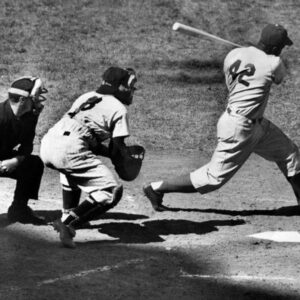What is war in baseball ? “Wins Above Replacement” (WAR) is a crucial statistic in the world of baseball. As baseball has evolved, so too have the methods used to analyze player performance and determine their worth to a team.
Enter Sabermetrics, the use of advanced baseball statistics to measure a player’s contributions on the field. With WAR, fans and analysts alike can get a comprehensive picture of a player’s worth. Rather than relying solely on traditional statistics like batting average and runs batted in, WAR takes into account a player’s offensive production, base running, fielding, and for pitchers, their pitching performance.
These contributions are then compared to those of a “replacement-level player,” a theoretical player who represents the baseline level of performance that could be readily found in the free-agent market or minor leagues.
Other important metrics in Sabermetrics include Weighted On-Base Average (WOBA) and runs created.
For the latest and most accurate WAR rankings and analysis, fans can turn to trusted sources like Baseball-Reference.com and FanGraphs.com.
In this blog post, we will explore what WAR is and how it is calculated, and its significance in the world of baseball statistics.

What is WAR?
WAR is a metric that quantifies how a player impacts the team, either positively or negatively. It measures how the team would perform if that player were replaced by a readily available minor league or bench player, known as a “replacement-level player.”
WAR encompasses the achievements of the team with that player on the field, including their contributions in hitting, base running, fielding, and pitching (for pitchers). It shows how valuable a player is to the roster by comparing them to a replacement-level player.
While it’s common for WAR values to fall between 0 and 6, these aren’t strict boundaries. Negative WAR values indicate a performance worse than a replacement-level player, and superstars in the league may achieve WAR values well above 6 in a single season.
To calculate a player’s WAR, you need to compile a multitude of statistics, including fielding, base running, hitting, runs scored, and runs allowed. The position a player plays and the league they play in can also affect the calculation. Independently, these statistics provide insight, but when calculated together in the context of WAR, they offer a comprehensive view of a player’s overall value to the team.
How do you calculate WAR?
Calculating WAR (Wins Above Replacement) is complex, and the exact methodology can vary depending on who is calculating it. There are different versions of WAR, such as fWAR (FanGraphs’ version) and bWAR (Baseball-Reference’s version), and they each have their own approach to the calculation.
The calculation of WAR is not represented by a simple, single formula, as it involves multiple components and steps. Here’s a general overview of the process for position players and pitchers
Different sources may include other factors or slight variations on these steps, but this provides a general overview of the process. It’s worth noting that WAR is typically calculated with the assistance of sophisticated statistical software, as it involves many detailed calculations and adjustments.
Is it a good statistic?
Statisticians argue that WAR is one of the most effective stats to use to evaluate players. WAR takes a cohesive and thorough look at a number of statistics. This perspective allows you to get a wider view of a player and how they can positively or negatively affect your team.
WAR is a stat that puts players and performances in context. Calculating WAR can be confusing, but once you have the stat completed, it will reveal a great deal about the player you are examining.
Who has the highest WAR all-time?
This is a complicated answer. The career leader for WAR all-time is Barry Bonds. Against position players, Bonds finished with a WAR of 162.8. He narrowly beat Ruth, who finished with a 162.7. The interesting tidbit about this is that this stat does not include Ruth’s time as a pitcher.
When including Ruth’s stats as a pitcher, he jumps to the top of the all-time WAR list. Ruth tops that list at 183.1. The next highest player on that list is also a pitcher. Walter Johnson comes in second at 164.8. In comparison, Bonds drops to fourth on the list.
Highest in a season?
The highest single-season WAR all-time for position players belongs to Babe Ruth. In fact, Ruth owns the top three spots on the all-time single-season list. In 1923, 28-year-old Ruth posted a 14.2 WAR. Barry Bonds is the highest-rated modern-era player. In 2001, Bonds posted an 11.9 WAR. This places him sixth on the all-time list.
What does Career WAR mean?
WAR is a comprehensive stat. A Career WAR shows collectively how many wins over a replacement your player collected over the course of their career. Comparing individual seasons to a career stat will show you if a season was an outlier (again, positively or negatively). The more a player plays, the more accurate and revealing their WAR may be.
Making the Case for WAR as Baseball’s Most Perfect Statistic
Wins Above Replacement, that is.
With sites like Baseball Reference, FanGraphs and Baseball Prospectus making all sorts of statistics easily accessible and readily available, there’s no shortage of interesting, intriguing, intelligent—even fun—metrics to consider.
But in the battle to be baseball’s best stat, WAR wins.
While the advanced metric may be a bit perplexing to some and certainly isn’t as popular or widespread as ol’ reliables like batting average, or runs batted in or even more new-age numbers like on-base percentage, WAR has it over all of them.

What is WAR in Baseball?
Wins Above Replacement Level, or WAR, is nothing more than a framework that attempts to summarize the entirety of a player’s contribution (fielding, baserunning, batting, or pitching) in one catch-all number. Certainly, like all metrics, baseball WAR is not perfect and it has its limitations depending upon whom you ask and what iteration you’re using. However, whatever your opinion is on the matter, it’s undeniable that in the year 2020, WAR in baseball has helped change the game forever.
In the past 2-3 years alone, WAR has influenced MVP and Cy Young races, helped sports writers rank and organize free agent lists, given fans a platform to evaluate the open market, and allowed analysts to determine how much a single draft selection is worth in present-day dollars.
In this sense, although WAR is just a framework by design, it functions as much more than that for those around the game. For us, baseball WAR is a gateway to better analyses, better evaluations, and better comprehension of the sport itself.
Above is information what is war in baseball. Hopefully, through the above content, you have a more detailed understanding of what is war in baseball .Thank you for reading our post.









